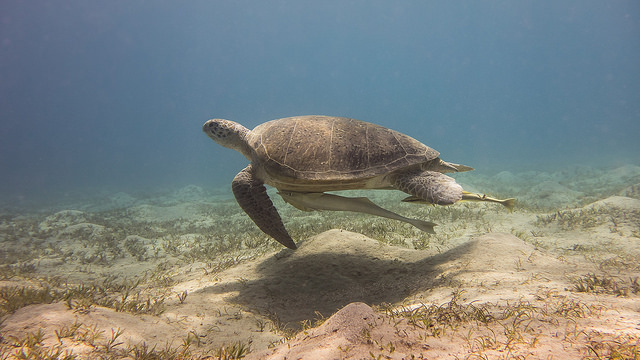
“We were training our students to write obituaries of the ocean,” said Dr. Nancy Knowlton about a program she co-founded in 2009 called the Scripps Center for Marine Biodiversity and Conservation. Dr. Knowlton is the Sant Chair for Marine Science at the Smithsonian and one of the panelists that took part in a conversation on Optimism for the Ocean at this year’s Capitol Hill Ocean Week.
Social science has shown that too much doom and gloom about the ocean and other environmental issues is depressing. While listening to relentless stories of how our Earth and ocean are dying may motivate a few people to take action in the short term, it is more likely to cause people to switch off and become apathetic. So how do we empower more people to take action? An appropriate dose of ocean and earth optimism! Relaying success stories in conservation can be an incredible motivational tool to take stock of what is already working and challenge people to scale up, or apply similar approaches to new locations and other projects.

One of the main challenges lies in being heard over media coverage–after all news is more likely to focus on what’s not working. And it’s not just the public that gets short-changed when stories are overwhelmingly negative. For example, Dr. Knowlton recounted a time when she asked a room full of scientists if they were aware that Tampa Bay seagrasses have returned to 1950s levels, only a handful raised their hands. Bottom line: we need to do a better job of sharing positive stories. The good news? We are starting to.
Dr. Knowlton helped launch the #OceanOptimism hashtag on Twitter back at a workshop in 2014. To date, it has reached more than 76 million Twitter accounts, and it is still one of the easiest ways to find examples of what is working in conservation. “It’s nuts” said Dr. Knowlton, “we need a better framework for people to find out what’s working”. Nevertheless, Twitter is still so effective in part because it allows anyone around the world to tag their stories. So, just a few months ago, a sister hashtag #EarthOptimism was launched in conjunction with the Earth Optimism Summit in Washington, D.C..

Robert (Bob) Dooley, a commercial fisherman and founding member of Seafood Harvesters of America was also on the panel. Bob had a great example of ocean optimism: The Magnuson Stevens Fishery Conservation and Management Act. The Magnuson Stevens Act is the primary law governing fisheries in U.S. waters. Bob described that before this act, fishermen were racing for fish. “When you race for fish without regulation, the price is paid by the fish…but you can’t have a fishery without fish”. However, the measures of the Act, including transparency and accountability of fish population assessments and harvest rates, helped and continue to ensure that fishermen catch the right fish at the right time for the right market. Fisheries in the U.S. are generally managed using a stock by stock basis. A stock is a group of target species (fish, shrimp or otherwise) within a well-defined area that participate in the same reproductive activity. Thanks to the Magnuson Stevens Act, the number of stocks subject to overfishing decreased by more than half within thirteen years (from 66 in 2003 to 30 in 2016). The best part is that lessons learned can be passed on to fisheries management in other countries.

Another panelist, Dr. Charles Littnan, lead scientist of the NOAA Fisheries’ Hawaiian Monk Seal Program spoke about his experience with monk seal conservation. Hawaiian monk seals (Neomonachus schauinslandi) are native to Hawaii and not found anywhere else in the world. They are also one of the most endangered marine mammals in the world because of low survival of young, low prey availability and historical hunting by humans. To date, approximately 20% of the Hawaiian monk seal population exists directly because of the program. However, Dr. Littnan cautioned that while talking about success gives people a cause worth fighting for, the context must also be communicated. For example, the population of monk seals has been increasing at 3% each year for the past three years; however, the work is not yet done and there is still a long way to go.
Conservation will always be in the hands of the next generation. Millennials are results and solutions-oriented, so getting them behind a cause requires demonstrating action being taken. However, this approach can work for other generations as well. Providing examples of success stories at the individual, community, corporate, province/state and federal level adds to the narrative that while issues are human-caused, solutions are as well. Hearing about people working towards a common goal gives people hope and an opportunity to see what level they can best get involved. Whether you switch to a coral reef safe sunscreen, you organize a shoreline clean up with your school, your building installs solar panels on its roof, your state/province is a leader in using wind power, or you found out that the West Indian manatee has been downlisted from endangered to threatened, let’s talk about it!
I’m a past oceanbites writer, occasional editor and guest poster. I graduated with a Masters of Coastal & Marine Management from the University of Akureyri in Iceland, and am currently working in marine conservation. In particular, I’m supporting an Indigenous-led initiative to safeguard the largest inland sea in the world (Hudson Bay & James Bay, Canada). I love weird ocean critters and *sigh…I really do enjoy long walks on the beach.

